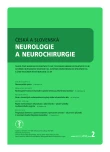Surgical Approaches to Thalamic Tumors
Authors:
M. Smrčka 1; E. Brichtová 2; Z. Mackerle 2; V. Juráň 1; V. Přibáň 1,3
Authors‘ workplace:
Neurochirurgická klinika LF MU a FN Brno
1; Klinika dětské chirurgie, ortopedie a traumatologie LF MU a FN Brno
2; Neurochirurgická klinika LF UK a FN Plzeň
3
Published in:
Cesk Slov Neurol N 2015; 78/111(2): 172-180
Category:
Original Paper
Overview
Introduction:
Thalamic tumours are relatively rare lesions growing in a highly functional part of the brain. They are more frequent in paediatric population. Their surgery is challenging and associated with a risk of significant morbidity. Relatively benign nature of many of these tumours suggests that radical resection should be attempted. The approach has to be very carefully planned, sometimes with help of modern diagnostic methods such as DTI. Location and projection of the tumour in the thalamus plays an important role in selecting an approach.
Material and methods:
During 2005–2014 we operated on 13 patients with thalamic tumours, mean age 20.6 years (1–64 years). These were 10 males and three females. Another 15-year-old male patient is being observed. Transcortical approach was used 7×, transcallosal 4×, transsylvian 2× and supracerebellar infratentorial 1×.
Results:
Gross total resection was achieved in six cases, subtotal in four and partial in three. There were eight pilocytic astrocytomas, one subependymal giant cell astrocytoma, one diffuse astrocytoma G II and three glioblastomas. Two older patients with glioblastomas died six and nine month after operation. All other patiens are still alive with the mean follow-up 5 years. Neurological status after the operation was good except for one older patient with glioblastoma who developed severe hemiparesis and aphasia.
Conclusion:
Thalamic tumours might be safely radically resected if correct approach is used. The choice of approach is based on the projection of the tumour. Smaller tumours that are not reach thalamic surface might be followed up or biopsied if there is a likelihood of their malignant nature. Oncological treatment should be reserved to malignant tumours.
Key words:
thalamic tumours – surgical approaches
The authors declare they have no potential conflicts of interest concerning drugs, products, or services used in the study.
The Editorial Board declares that the manuscript met the ICMJE “uniform requirements” for biomedical papers.
Sources
1. Sai Kiran NA, Thakar S, Dadlani R, Mohan D, Furtado SV, Ghosal N et al. Surgical management of thalamic gliomas: case selection, technical considerations, and review of literature. Neurosurg Rev 2013; 36(3): 383– 393. doi: 10.1007/ s10143‑ 013‑ 0452‑ 3.
2. Rhoton A. Cranial anatomy and surgical approaches. Baltimore: Lippincott Williams & Wilkins 2003.
3. Moshel YA, Elliott RE, Monoky DJ, Wisoff JH. Role of diffusion tensor imaging in resection of thalamic juvenile pilocytic astrocytoma. J Neurosurg Pediatr 2009; 4(6): 495– 505. doi: 10.3171/ 2009.7.PEDS09128.
4. Cuccia V, Monges J. Thalamic tumors in children. Childs Nerv Syst 1997; 13: 514– 520.
5. Özek MM, Türe U. Surgical approach to thalamic tumors. Childs Nerv Syst 2002; 18: 450– 456.
6. Albright AL. Feasibility and advisability of resections of thalamic tumors in pediatric patients. J Neurosurg 2004; 100 (Suppl 5): 468– 472.
7. Puget S, Crimmins DW, Garnett MR, Grill J, Oliveira R, Boddaert N et al. Thalamic tumors in children: a reappraisal. J Neurosurg 2007; 106 (Suppl 5): 354– 362.
8. Ishii R, Suzuki Y, Watanabe A, Mouri Y, Ishii N, Yoshii I. Gross total removal of gliomas in the pulvinar and correlative microsurgical anatomy. Neurol Med Chir 2002; 42(12): 536– 545.
9. Brodway SJ, Ogg RJ, Scoggins MA, Sanford R, Patay Z, Boop FA. Surgical management of tumors producing the thalamopeduncular syndrome of childhood. J Neurosurg Pediatr 2011; 7(6): 589– 595. doi: 10.3171/ 2011.4.PEDS119.
10. Moshel YA, Link MJ, Kelly PJ. Stereotactic volumetric resection of thalamic pilocytic astrocytomas. Neurosurgery 2007; 61(1): 66– 75.
11. Nayar VV, Foroozan R, Weinberg JS, Yoshor D. Preservation of visual fields with inferior temporal gyrus approach to the atrium. J Neurosurg 2009; 110(4): 740– 743. doi: 10.3171/ 2008.6.17606.
12. Bilginer B, Narin F, Isikay I, Oguz KK, Soylemezoglu F,Akalan N. Thalamic tumors in children. Childs Nerv Syst 2014; 30(9): 1493– 1498. doi: 10.1007/ s00381‑ 014‑ 2420‑ 9.
13. Baroncini M, Vinchon M, Mineo JF, Pichon F, Francke JP,Dhellemmes P. Surgical resection of thalamic tumors in children: approaches and clinical results. Childs Nerv Syst 2007; 23(7): 753– 760.
14. Drake JM, Joy M, Goldenberg A, Kreindler D. Computer‑ and robot‑ assisted resection of thalamic astrocytomas in children. Neurosurgery 1991; 29(1): 27– 33.
15. El Beltagy MA, Aggag M, Kamal M. Role of intraoperative ultrasound in resection of pediatric brain tumors. Childs Nerv Syst 2010; 26(9): 1181– 1193. doi: 10.1007/ s00381‑ 010‑ 1091‑ 4.
16. Konovalov AN, Kadyrov SU. Surgical approaches to thalamic tumors. Zh Vopr Neirokhir Im N N Burdenko 2011; 75(1): 4– 11.
Labels
Paediatric neurology Neurosurgery NeurologyArticle was published in
Czech and Slovak Neurology and Neurosurgery

2015 Issue 2
- Metamizole vs. Tramadol in Postoperative Analgesia
- Memantine in Dementia Therapy – Current Findings and Possible Future Applications
- Memantine Eases Daily Life for Patients and Caregivers
- Metamizole at a Glance and in Practice – Effective Non-Opioid Analgesic for All Ages
- Advances in the Treatment of Myasthenia Gravis on the Horizon
Most read in this issue
- Aggressive Vertebral Hemangioma
- Neuromyelitis Optica
- Congenital Central Hypoventilation Syndrome (Ondine‘s Curse)
- Radiologic Assessment of Lumbar Spinal Stenosis and its Clinical Correlation
